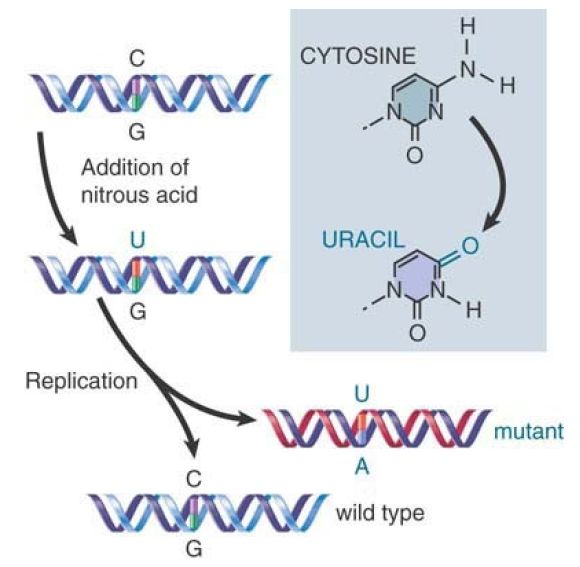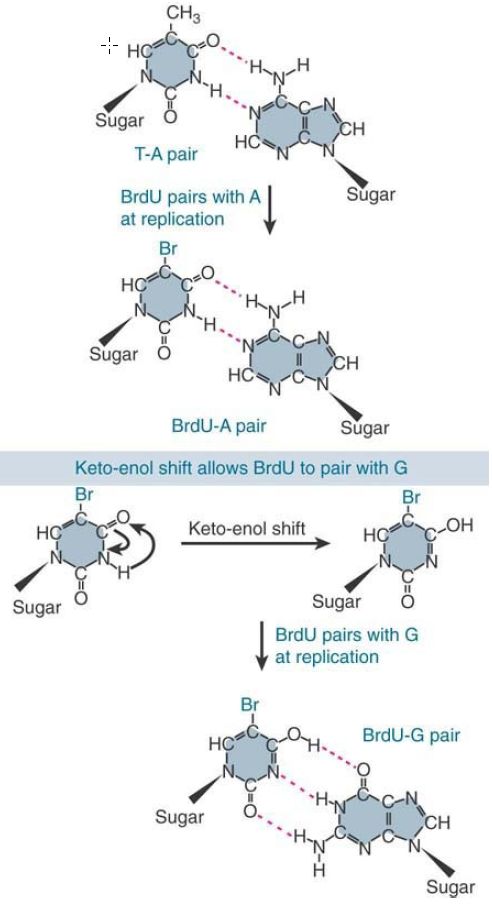


 النبات
النبات
 الحيوان
الحيوان
 الأحياء المجهرية
الأحياء المجهرية
 علم الأمراض
علم الأمراض
 التقانة الإحيائية
التقانة الإحيائية
 التقنية الحيوية المكروبية
التقنية الحيوية المكروبية
 التقنية الحياتية النانوية
التقنية الحياتية النانوية
 علم الأجنة
علم الأجنة
 الأحياء الجزيئي
الأحياء الجزيئي
 علم وظائف الأعضاء
علم وظائف الأعضاء
 الغدد
الغدد
 المضادات الحيوية
المضادات الحيوية|
Read More
Date: 2025-03-17
Date: 3-1-2016
Date: 10-3-2021
|
Mutations Can Affect Single Base Pairs or Longer Sequences
KEY CONCEPTS
-A point mutation changes a single base pair.
-Point mutations can be caused by the chemical conversion of one base into another or by errors that occur during replication.
-A transition replaces a G-C base pair with an A-T base pair, or vice versa.
-A transversion replaces a purine with a pyrimidine, such as changing A-T to T-A.
-Insertions and/or deletions can result from the movement of transposable elements.
Any base pair of DNA can be mutated. A point mutation changes only a single base pair and can be caused by either of two types of event:
- Chemical modification of DNA directly changes one base into a different base.
- An error during the replication of DNA causes the wrong base to be inserted into a polynucleotide.
Point mutations can be divided into two types, depending on the nature of the base substitution:
-The most common class is the transition, which results from the substitution of one pyrimidine by the other, or of one purine by the other. This replaces a G-C pair with an A-T pair, or vice versa.
-The less common class is the transversion, in which a purine is replaced by a pyrimidine, or vice versa, so that an A-T pair becomes a T-A or C-G pair.
As shown in FIGURE 1., the mutagen nitrous acid performs an oxidative deamination that converts cytosine into uracil, resulting in a transition. In the replication cycle following the transition, the U pairs with an A, instead of the G with which the original C would have paired. So the C-G pair is replaced by a T-A pair when the A pairs with the T in the next replication cycle. (Nitrous acid can also deaminate adenine, causing the reverse transition from A-T to GC.)

FIGURE 1. Mutations can be induced by chemical modification of a base.
Transitions are also caused by base mispairing, which occurs when noncomplementary bases pair instead of the conventional G-C and A-T base pairs. Base mispairing usually occurs as an aberration resulting from the incorporation into DNA of an abnormal base that has flexible pairing properties. FIGURE 2. shows the example of the mutagen bromouracil (BrdU), an analog of thymine that contains a bromine atom in place of thymine’s methyl group and can be
incorporated into DNA in place of thymine. BrdU has flexible pairing properties, though, because the presence of the bromine atom allows a tautomeric shift from a keto (=O) form to an enol (–OH) form. The enol form of BrdU can pair with guanine, which after replication leads to substitution of the original A-T pair by a G-C pair.

FIGURE 2. Mutations can be induced by the incorporation of base analogs into DNA.
The mistaken pairing can occur either during the original incorporation of the base or in a subsequent replication cycle. The transition is induced with a certain probability in each replication cycle, so the incorporation of BrdU has continuing effects on the sequence of DNA.
Point mutations were thought for a long time to be the principal means of change in individual genes. We now know, though, that insertions of short sequences are quite frequent. Often, the insertions are the result of transposable elements, which are sequences of DNA with the ability to move from one site to another .
An insertion within a coding region usually abolishes the activity of the gene because it can alter the reading frame; such an insertion is a frameshift mutation. (Similarly, a deletion within a coding region is usually a frameshift mutation.) Insertions of transposable elements can subsequently result in deletion of part or all of the inserted material, and sometimes of the adjacent regions.
A significant difference between point mutations and insertions is that mutagens can increase the frequency of point mutations, but do not affect the frequency of transposition. Both insertions and deletions of short sequences (often called indels) can occur by other mechanisms, however—for example, those involving errors during replication or recombination. In addition, a class of mutagens called the acridines introduces very small insertions and deletions.



|
|
|
|
4 أسباب تجعلك تضيف الزنجبيل إلى طعامك.. تعرف عليها
|
|
|
|
|
|
|
أكبر محطة للطاقة الكهرومائية في بريطانيا تستعد للانطلاق
|
|
|
|
|
|
|
أصواتٌ قرآنية واعدة .. أكثر من 80 برعماً يشارك في المحفل القرآني الرمضاني بالصحن الحيدري الشريف
|
|
|